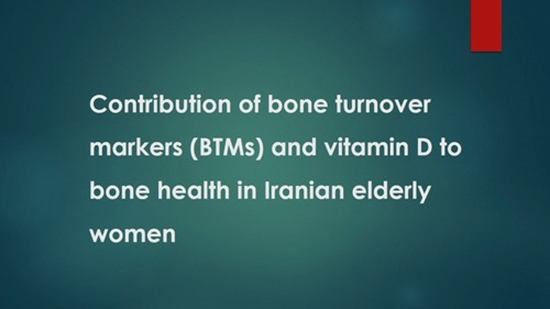Contribution of bone turnover markers (BTMs) and vitamin D to bone health in Iranian elderly women
While only a few postmenopausal women exhibit biochemical signs of hypovitaminosis D, it has been shown that vitamin D insufficiency has detrimental effects on the overall skeleton mineralization, bone turnover rate, and may be a significant risk factor for osteoporosis and fracture. We evaluated the concurrent effect of Vitamin D levels and biochemical markers of bone turnover on bone health of postmenopausal women.

Abstract
Purpose
While only a few postmenopausal women exhibit biochemical signs of hypovitaminosis D, it has been shown that vitamin D insufficiency has detrimental effects on the overall skeleton mineralization, bone turnover rate, and may be a significant risk factor for osteoporosis and fracture. We evaluated the concurrent effect of Vitamin D levels and biochemical markers of bone turnover on bone health of postmenopausal women.
Methods
The present study was conducted within the framework of the Bushehr Elderly Health (BEH) program, a population-based prospective cohort study being conducted in Bushehr, a southern province of Iran. In summary, 400 persons from participants of the second stage were selected; serum bone turnover markers (bone-specific alkaline phosphatase (bALP), amino‐terminal procollagen propeptides of type I collagen (P1NP), osteocalcin (OC), tartrate‐resistant acid phosphatase isoenzyme 5b (TRAP)) and vitamin D were measured. Vitamin D deficiency was defined as serum 25(OH) D below 20 ng/ml, and Bone health was considered in terms of Osteoporosis and degraded bone microarchitecture.
Results
The number of partially or significantly degraded microstructure based on TBS was higher than the number of osteoporotic women based on BMD. Women with higher CTX levels were more prone to being degraded microarchitecture. Although we couldn’t find any association between vitamin D deficiency and bone health, when we considered the vitamin D levels in univariable modelling, the effect of it was significant.
Conclusions
In this study, only CTX was found to be significantly correlated with TBS while BMD was associated with CTX, OC, and TRAP.




ارسال نظر